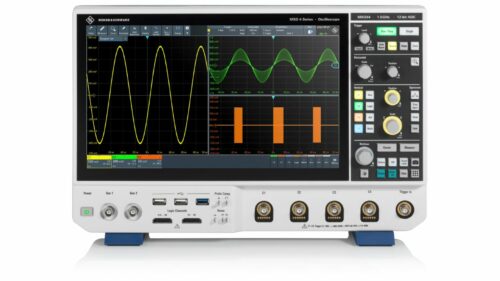With ASIC-based zone triggering, offering the MXO series the fastest update rate (600,000 waveforms/sec) and precise event isolation, outperforming competitors by up to 10,000 times.

Rohde & Schwarz has introduced the industry’s first ASIC-based zone triggering in its new MXO series oscilloscopes. This development enhances the precision of isolating events that are challenging or impossible to detect with traditional oscilloscope triggers. The MXO zone trigger implementation is the fastest in the industry, significantly surpassing existing solutions.
The key features are:
- Bandwidth: 200 MHz – 1.5 GHz and 4 channel: 350 MHz – 2 GHz | 8 channel: 100 MHz – 2 GHz
- World’s first oscilloscope with over 4.5 million waveforms per second
- 45,000 FFT/s spectrum acquisition rate, supporting up to 4 spectra.
- Zone trigger on analog, spectrum and math
- Deepest in class standard memory: 400 and 500 Mpoints
Traditional triggers, such as edge triggering, are often difficult to configure and may be inadequate for visualizing certain events. Zone triggering allows users to specify conditions by drawing zone areas on the display. The oscilloscope inspects each acquisition for these conditions and displays events that meet the criteria, discarding waveforms that do not. This method is effective for triggering on non-monotonic edges, serial bus patterns, math waveforms, events across multiple channels, and frequency domain events. These use cases are often problematic for traditional triggers. The new zone triggering is the first ASIC-based solution working on analog channel signals, math, and spectrum.
The chip design allows for future hardware acceleration capabilities, ensuring ongoing provision of new functionalities. The MXO zone triggering provides additional capabilities without significant trigger blind times, a common issue with software-based zone triggering solutions. The MXO zone triggering allows users testing and debugging in the frequency domain to draw specific zone areas. The oscilloscope triggers or activates when a tone exceeds a set power level within these zones. Users can also draw zones for RF chirps or pulses. The new MXO’s free run mode captures as fast as possible without looking for an edge trigger event, which, when combined with zone triggering, is effective for power integrity measurements and EMI debug. A unique feature of the MXO zone triggering is its ability to store waveforms in real-time that match zone trigger criteria, enabling users to focus on specific relevant events.
Philip Diegmann, Vice President Oscilloscopes at Rohde & Schwarz, states that the next-generation MXO-EP processing ASIC technology is the foundation of the MXO series’ advanced signal visibility and user responsiveness.
For more information, click here.






